کمپرسور اسکرو
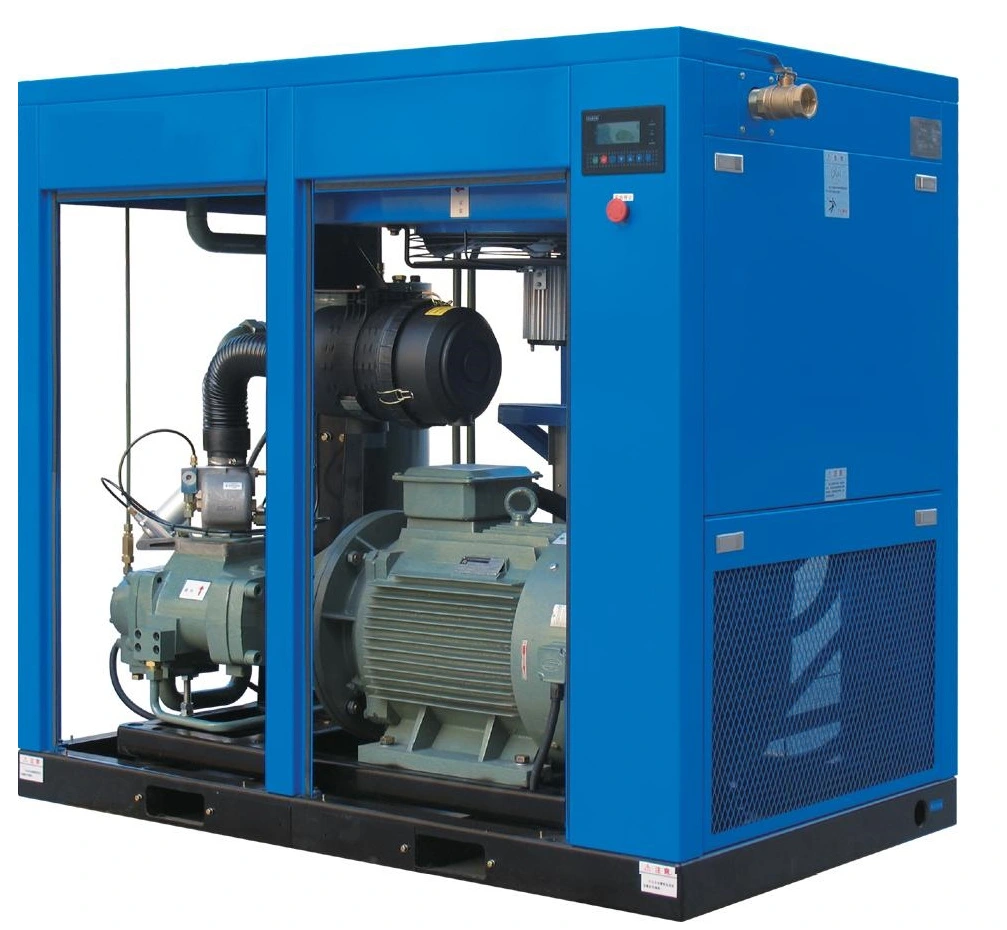
Screw compressor
Oil compressor (Oil Inject)
Description:
In the oil screw compressor, the oil injected into the compression chamber is mixed with the compressed gas at the end of the compression process, and after leaving the compression chamber in a separator trap, it is separated from the condensed gas and returned to the compression chamber after cooling and filtration. will be
The oil screw compressor is a desirable method for cases where the presence of small amounts of oil in the compressed gas (such as air) is not a problem. But if the presence of oil even in small amounts is not acceptable, the use of microfilter separator filters is inevitable. In such cases, the oil screw compressor operator must pay more attention to keeping the filter separating oil from gas clean.
One of the characteristics of the oil screw compressor is that the output pressure does not depend much on the molecular weight of the compressed gas. Therefore, for those cases where the percentage of components of the compressed gas is constantly changing, this oil screw compressor can work with relatively constant efficiency (a situation that can cause many problems in centrifugal compressors).
The presence of oil increases the efficiency and pressure in the compressor, and also due to the low working temperature in oil compressors (about 80 degrees Celsius), the life of the compressor parts is much longer. If the presence of small amounts of oil in the produced compressed air is not important, it is recommended to use this type of compressor, and in applications that are more sensitive, micron oil particles can be separated from the compressed air by using a micro filter, but it must be This point was noted that to produce quality air, filters should be replaced and cleaned at designated times.
Types of oil screw compressors
Oil screw compressors are produced in different types of belt, direct coupling, variable speed and fixed speed. Below is a brief explanation of them:
- Power transmission in the oil screw compressor is possible in three forms: direct coupling, belt and gearbox, each of which is designed and manufactured according to the customer's needs.
- Power transmission is possible in direct coupling screw compressor with coupling.
- Power transmission in belt models is possible by grooved pulleys and belts.
- It is possible to transfer power in a screw compressor with a gearbox model
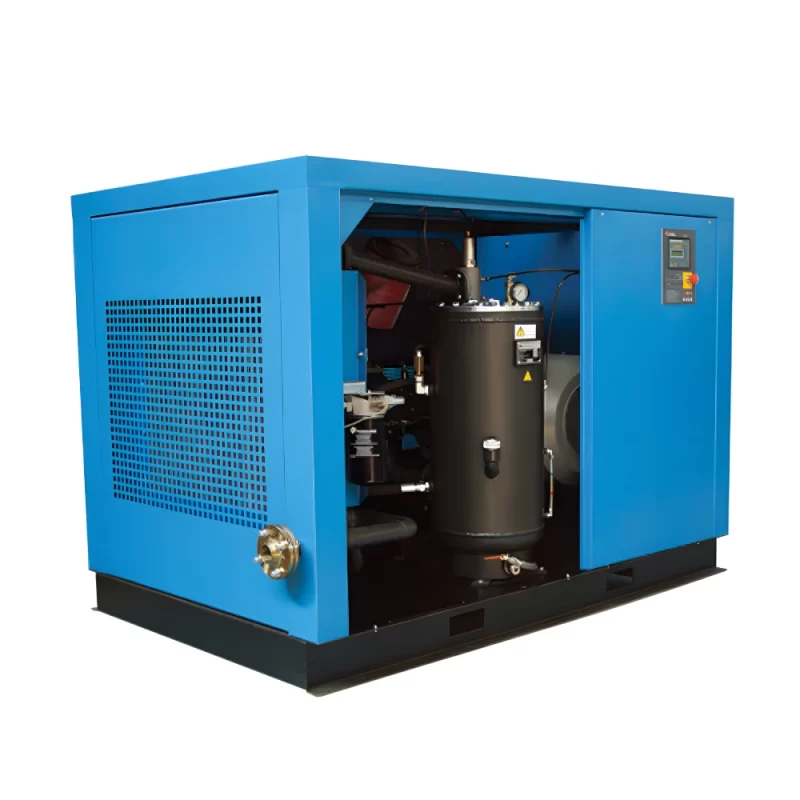
Belt oil screw compressor
In belt compressors, the electric motor and air conditioner are connected to each other in the form of a belt, and compared to direct coupling compressors, they have a quieter and smoother operation, because in the belt system, the existence of a lubricated belt reduces the amount of noise and makes it more efficient. be made In this category of compressors, if the belt breaks, it can be replaced or repaired and the compressor can be used again.
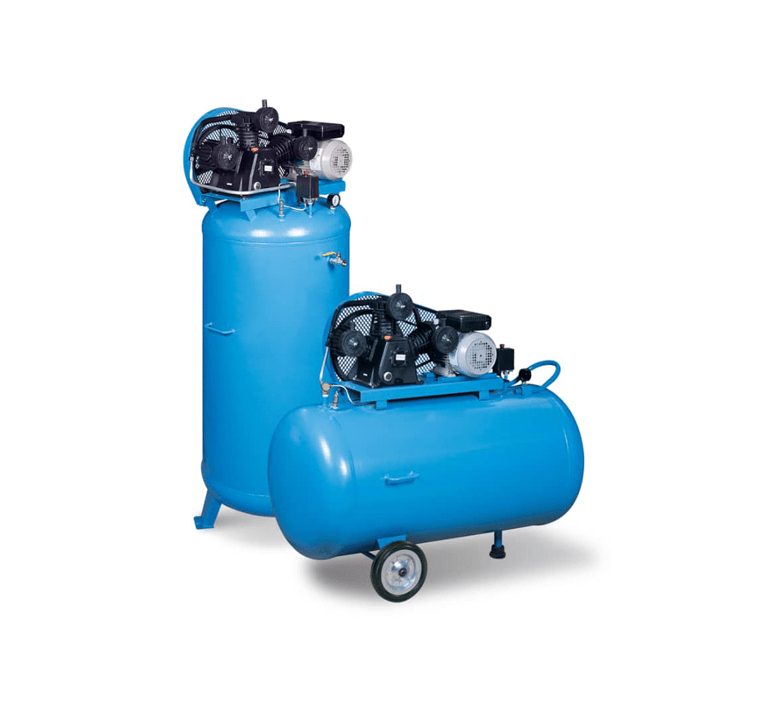
Types of oil screw compressors
In direct coupling oil screw compressors, electric motor and air generator are coupled to each other. In this category of compressors, operation and maintenance is easier than belt compressors. Also, the efficiency and effectiveness of direct coupling compressors are higher than belt compressors.
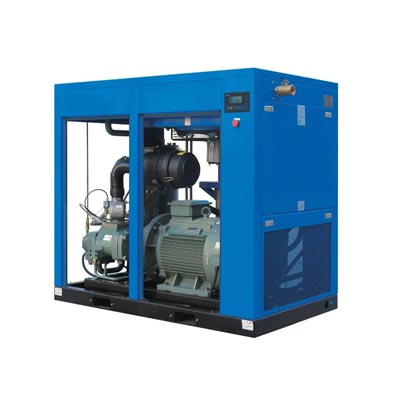
Constituent implementation of oil compressors
1- Intake air filter
2- Unloader
3- Air conditioner unit
4- The path of air and oil mixture exiting from the air generator unit
5- Oil and air separator receiver
6- Minimum valve
7- Air cooling radiator
9- Moisture absorbent
12- Oil cooling radiator
13- Return oil path
14- Oil filter
15- return oil input to air conditioner unit

Screw compressor without oil (Oil Free)
Oil-free means without oil and this word is often used in sensitive and food industries. In all industrial machines that have moving parts, industrial oils are used for lubrication and sometimes cooling operations, and they are also used in feeding and sensitive processes.
In some industries, due to the presence of sensitivity in equipment or health issues, isolated air and free of any oil is needed. The task of supplying oil-free compressed air in large industries is the responsibility of oil-free screw compressors or oil-free compressors.
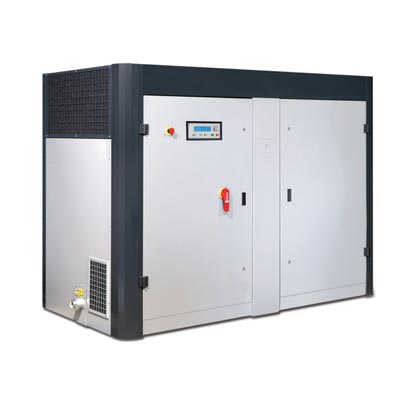
Technical specifications of oil-free screw compressor
Oil-free compressed air compressors are designed and manufactured in the form of water injection in relatively low to medium powers, which work exactly like oil screw compressors, with the difference in oil-free air compressors that instead of oil, water is injected into the compression chamber. be made At powers higher than 50 kW, the design of the oil-free screw compressor is such that the oil is only in the housing part and inside the gears and bearings, and the rotors rotate with very little tolerance and usually due to In the presence of very high heat, the screws are made of polyceramic material.
Oil-free air compressors are made in two forms, one-stage oil-free screw compressors and 2-stage oil-free screw compressors, according to the required working pressure. It is compressed and after the initial cooling in the intercooler, it enters the high pressure air conditioning unit and is compressed to the desired amount and after cooling in the aftercooler, it comes out of the compressor.
The power transmission mechanism in the oil-free screw compressor is provided by the gears that are outside the compression chamber, and its structure is such that the rotors do not contact each other and the shell, therefore, there is no need for oil in these compressors. There is no, but due to the lack of contact between the coolant and the lubricant, there is a very high depreciation in these compressors.
The type of connection between the electric motor and the cylinder in the oil-free compressor is a direct coupling type. In the oil-free screw compressor, materials such as water are used instead of oil in the compressor cycle. The way it works is that the outside air enters the compressor after passing through the air filters, and the process of compression begins, then it is compressed by the compressor elements. Compressed air increases in temperature after compression due to the lack of cooling material, therefore, after compression, it enters the cooler and its temperature decreases. During the cooling of compressed air, moisture and steam may be created, for this reason, there are filters in the cooling system to separate moisture from compressed air. Separating moisture from compressed air prevents damage to compressor parts. After cooling the compressed air, the air returns to the compressor circuit and the compression process is repeated, then the compressed air enters the second cooler and after cooling it is stored in the compressed air tank of the compressor.

